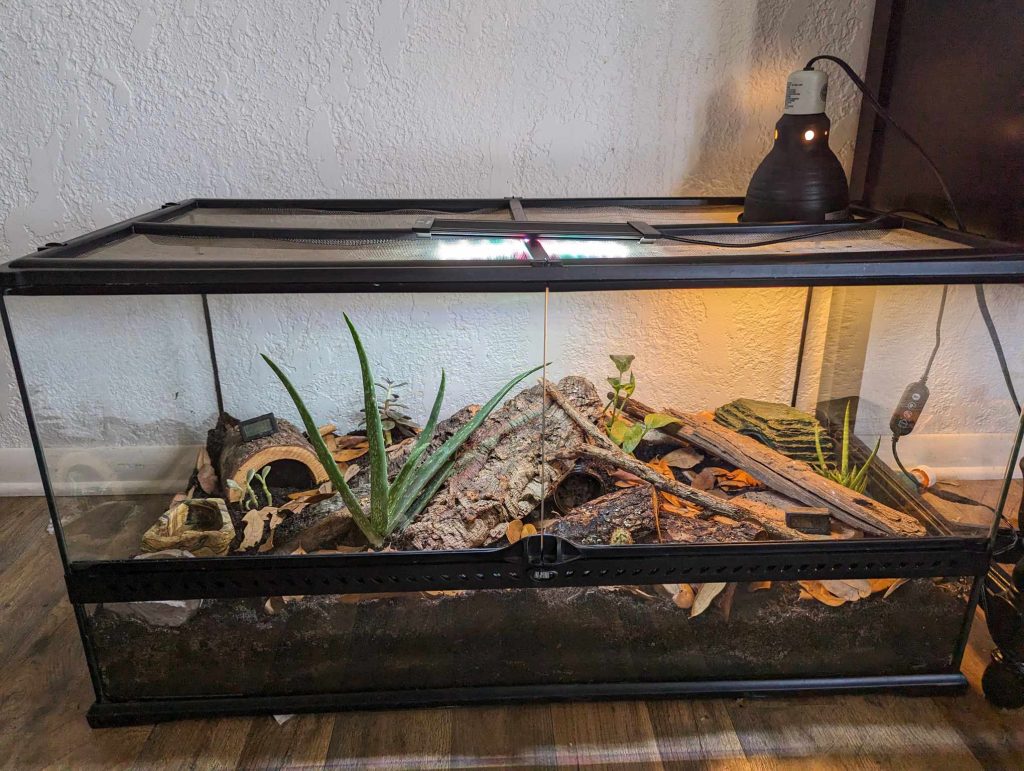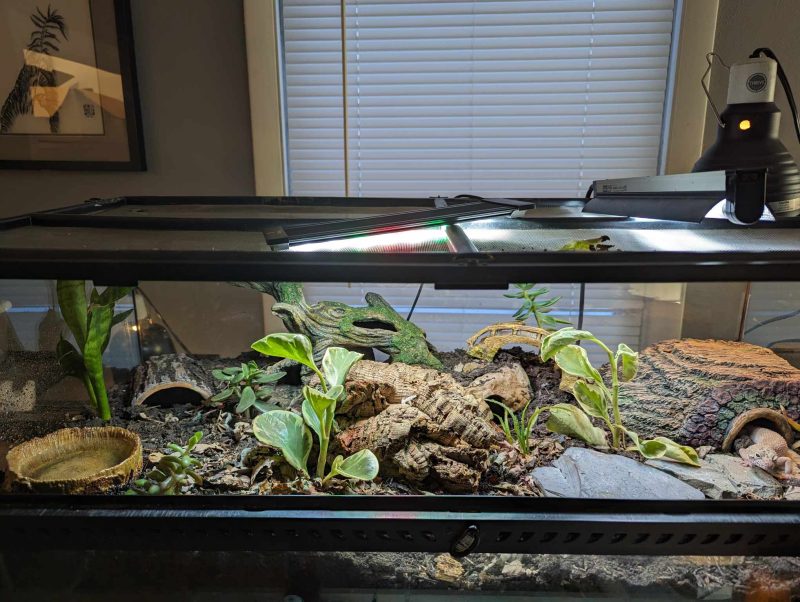Leopard geckos, those adorable spotted lizards, are amazing pets. But, just like any animal, they have specific needs. One of the biggest things new gecko owners struggle with is choosing the right kind of home. So, let’s fix that!
What is the Optimal Leopard Gecko Tank Size
Choosing the ideal enclosure for your leopard gecko is about more than just getting a tank that fits on your shelf. Size matters – a cramped space can stress a gecko out and make them more prone to illness. While those little leopard geckos might seem happy enough in a tiny tank at first, they grow like weeds!
Minimum and Ideal Dimensions for Leopard Gecko Tanks
I always recommend erring on the side of more space. While a 10-gallon tank can be an okay temporary fix for a baby or juvenile gecko, a 20 or even 30-gallon tank will go a long way. It gives them room to grow, but it also means you can pack in more hides, climbing spots, and fun stuff to keep your gecko entertained.
A full-grown leopard gecko needs at least a 20-gallon tank – but honestly, 30 or 40 gallons is even better. These guys might be small, but they’re explorers at heart. Think of a larger tank as giving them the roaming space they’d naturally crave in the wild!
I know what you’re thinking…an ideal dimension for a Leo, I recommend a minimum floor space equivalent to a 36″ x 18″ x 18″ tank for a single adult gecko. This gives them plenty of room to stretch their legs and explore.
Things to Keep in Mind
- More Geckos, More Room: If you’re thinking of getting your gecko a friend (or two), you’ll need to upgrade the tank size accordingly. And remember, housing geckos together takes careful planning and observation.
- Decor Matters: All those hides, branches, and cool substrates add up—plan for those when considering tank size.
- Length Over Height: Remember, leopard geckos are ground-dwellers. A long, wide tank is way better than a tall one they can’t fully utilize.

Consequences of Inadequate Tank Size on Leopard Gecko
Imagine living your entire life confined to a single cramped room. There is no space to stretch out, no interesting corners to explore, and a constant feeling of being trapped. For a leopard gecko, an undersized tank creates this same bleak reality.
Behavioral Issues in Leopard Geckos
- No Escape from the Everyday: They’re bright critters, and without room to explore, boredom sets in, which turns into stress. You might see Leo always sleeping, acting reclusive, or even grumpy.
- Going a Little Stir Crazy: When there’s no space, they’ll start climbing the walls, pacing, or sometimes acting territorial towards other geckos they have to share a cramped home with.
But there’s a catch… the negative impacts go beyond being uncomfortable.
Health Problems Arising from Small Enclosures
- Keeping Things Balanced: A small tank is a breeding ground for bacteria. Keeping the heat and humidity in the right range is also hard. And that’s a recipe for infections, breathing problems, and even digestive trouble.
- “Cabin Fever” for Lizards: Leos gain weight easily, and with no room to exercise, you’ll have a chubby gecko. That leads to a whole host of other health issues.
Can You Keep Multiple Leopard Geckos in a Single Tank?
Leopard geckos don’t live in packs. Even if cohabitation can work in specific cases, one of your leo behavior can change from a day to another. This can result in injuries or worse. It is never a very good idea to keep two leopard geckos together.
If you have several leos, they can still meet occasionally outside of their respective tanks, in neutral territories. Keep an eye open to see if everything goes well!

Housing Options for Multiple Leopard Geckos
If your geckos need their own spaces, looking into a vivarium stack makes sense. These have multiple tanks stacked on each other, saving space while giving each gecko their own home.
Leopard Gecko Tank Recommendations
When it comes to your leopard gecko’s tank, size absolutely matters! Bigger is always better, and minimum floor space is equivalent to a 36″ x 18″ x 18″ tank for a single adult gecko is considered best. This allows them to roam, explore, and exhibit their natural behaviors.
Let’s break down the common tank sizes and why some just aren’t good enough:
10 Gallon (Temporary Housing Only)
These are way too small for anything but a temporary setup. And I mean very temporary. If you’ve got a baby gecko, be ready to upgrade within a few months – these little guys grow fast!
Zilla 10 Gallon Pet Reptile Starter Habitat: This one’s slightly better than other starter kits, gives them a bit more room, and the mesh top is good for airflow. Okay for the very short term.
20 Gallons: Just Enough, But You Can Do Better
Okay, a lot of places call this the standard. But, honestly, I consider it the absolute bare minimum for an adult. Creating a truly stimulating environment in such a small space is hard – you need enough hides, different temperature spots, and some enrichment to keep your gecko happy.
REPTI ZOO Front Opening Reptile Tank: I like the front doors on this one – it makes cleaning and interacting with your gecko easier. Plus, it’s got more space for them to roam.
Exo Terra Outback Terrarium: Similar to the REPTI ZOO, bit more depth, and the front doors lock securely.
30+ Gallons: Your Gecko’s Dream Home
Now, this is where we’re talking! Tanks this size give you room to create a genuinely enriching setup for your gecko. You can have all those important elements – like hides, their basking spot, humid hide, water dishes – and even room for climbing and exploring.
NEPTONION 48 Gallon Glass Terrarium 36″x18″x18″: This is a great pick if you want the best for your gecko—lots of space for them to thrive.
Custom Reptile Habitats: If you want something truly special, a custom tank can be tailored to your gecko’s personality and your space. These last forever and give you total control.
Take Care!
Remember, your gecko might be small, but it has big dreams of exploring! Choosing the right tank is more than just fitting one on your shelf. A spacious, well-designed enclosure allows your gecko to stretch its legs, hide when it needs privacy, and be its awesome, lizardy selves. So give them the gift of space, and you’ll have one happy, healthy gecko!
Did this article spark your gecko-habitat creativity? Share your ideas and experiences in the comments below!


